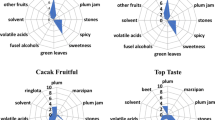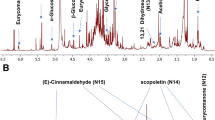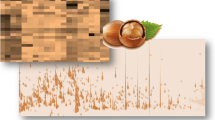Abstract
Natural extracts used in flavour and fragrances are exposed to authentication issues. Companies working in this industrial market acquire the raw materials locally but also abroad, sourcing exotic plants with specific olfactive features or lower costs of production. The geographical origin, the botanical variety, environmental conditions, extraction processes and storage conditions represent some parameters affecting the natural extract quality. All these factors are likely to affect the sensorial properties and especially the organoleptic characteristics of the extract. In addition, fraudulent practices known as adulterations have also an impact on the quality. Sensitive and precise analytical techniques are required to identify adulterations among other sources of variability. In this context, the highly valuable rose absolute was selected as a model study for its importance in perfumery. The existence of two botanical species and several production countries are additional reasons that make this extract an interesting case study. Because the usual GC–MS metabolomic approach is not able to cover the broad range of non-volatile compounds, complementary approaches are required. An UHPLC-ToFMS fingerprinting approach was therefore developed to allow the identification of non-volatile markers of the two closely related species of the genus Rosa. Thus, 12-oxophytodienoic acid was identified as a biomarker (level 2 according to MSI guideline) enabling the distinction between R. centifolia and R. damascena. Our results finally underline the efficiency of the UHPLC-ToFMS metabolomic approach for the qualification of odorant extracts.




Similar content being viewed by others
References
Aycı, F., Aydınlı, M., Bozdemir, Ö. A., & Tutaş, M. (2005). Gas chromatographic investigation of rose concrete, absolute and solid residue. Flavour Fragrance Journal, 20(5), 481–486.
Bauer, K., Garbe, D., & Surburg, H. (2001). Common fragrance and flavor materials (4th ed.). Weinheim: Wiley-VCH.
Buiarelli, F., Cartoni, G. P., Coccioli, F., & Ravazzi, E. (1991). Analysis of orange and mandarin essential oils by HPLC. Chromatographia, 31(9–10), 489–492.
De Vos, R. C., Moco, S., Lommen, A., Keurentjes, J. J., Bino, R. J., & Hall, R. D. (2007). Untargeted large-scale plant metabolomics using liquid chromatography coupled to mass spectrometry. Nature Protocols, 2(4), 778–791.
Do, T.K.T., Hadji-Minaglou, F., Antoniotti, S., & Fernandez, X. (2015). Authenticity of essential oils. Trends in Analytical Chemistry 66, 146–157.
Fernandez, X., Lizzani-Cuvelier, L., Loiseau, A.-M., Périchet, C., & Delbecque, C. (2003). Volatile constituents of benzoin gums: Siam and Sumatra. Part 1. Flavour Fragrance Journal, 18(4), 328–333.
Garnero, J., Guichard, G., & Buil, P. (1976). L’huile essentielle et la concrète de rose de Turquie. Rivista italiana essenze profumi piante officinali aromi saponi cosmetici aerosol n° ind (1976.03).
Glauser, G., Veyrat, N., Rochat, B., Wolfender, J. L., & Turlings, T. C. (2013). Ultra-high pressure liquid chromatography-mass spectrometry for plant metabolomics: A systematic comparison of high-resolution quadrupole-time-of-flight and single stage Orbitrap mass spectrometers. Journal of Chromatography A, 1292, 151–159.
Guenther, E. (1952). The essential oils. New York: D. Van Nostrand Company.
Hanhineva, K., Rogachev, I., Kokko, H., Mintz-Oron, S., Venger, I., Kärenlampi, S., & Aharoni, A. (2008). Non-targeted analysis of spatial metabolite composition in strawberry (Fragaria x ananassa) flowers. Phytochemistry, 69(13), 2463–2481.
Jirovetz, L., Buchbauer, G., Stoyanova, A., Balinova, A., Guangjiun, Z., & Xihan, M. (2005). Solid phase microextraction/gas chromatographic and olfactory analysis of the scent and fixative properties of the essential oil of Rosa damascena L. from China. Flavour Fragrance Journal, 20(1), 7–12.
Kim, N., Kim, K., Choi, B. Y., Lee, D., Shin, Y. S., Bang, K. H., et al. (2011). Metabolomic approach for age discrimination of Panax ginseng using UPLC-Q-Tof MS. Journal of Agriculture and Food Chemistry, 59(19), 10435–10441.
Kreis, P., & Mosandl, A. (1992). Chiral compounds of essential oils. Part XII. Authenticity control of rose oils, using enantioselective multidimensional gas chromatography. Flavour Fragrance Journal, 7(4), 199–203.
Ku, K. M., Choi, J. N., Kim, J., Kim, J. K., Yoo, L. G., Lee, S. J., et al. (2010). Metabolomics analysis reveals the compositional differences of shade grown tea (Camellia sinensis L.). Journal of Agriculture and Food Chemistry, 58(1), 418–426.
Li, Y-q, Kong, D-x, & Wu, H. (2013). Analysis and evaluation of essential oil components of cinnamon barks using GC–MS and FTIR spectroscopy. Industrial Crops and Products, 41, 269–278.
Masson, J., Liberto, E., Brevard, H., Bicchi, C., & Rubiolo, P. (2014). A metabolomic approach to quality determination and authentication of raw plant material in the fragrance field. Iris rhizomes: A case study. Journal of Chromatography A, 1368, 143–154.
Mattoli, L., Cangi, F., Maidecchi, A., Ghiara, C., Ragazzi, E., Tubaro, M., et al. (2006). Metabolomic fingerprinting of plant extracts. Journal of Mass Spectrometry, 41(12), 1534–1545.
Mazollier, A. (2012). Développement de méthodologies analytiques et statistiques innovantes pour le contrôle de l’authenticité de matières premières pour les industries de la cosmétique et de la parfumerie, PhD in chemistry, Université Claude Bernard Lyon 1, Lyon.
McHale, D., & Sheridan, J. B. (1988). Detection of adulteration of cold-pressed lemon oil. Flavour Fragrance Journal, 3(3), 127–133.
Mehl, F., Marti, G., Boccard, J., Debrus, B., Merle, P., Delort, E., et al. (2014). Differentiation of lemon essential oil based on volatile and non-volatile fractions with various analytical techniques: A metabolomic approach. Food Chemistry, 143, 325–335.
Monin, C. (2010). L’Encyclopédie des Matières Premières Naturelles pour la Parfumerie. vol 1.0.0.1. Hubsoft.
Naves, Y.-R. (1974). Technologie et Chimie des Parfums Naturels. Paris: Masson et CIE.
Ravid, U., Putievsky, E., Katzir, I., Ikan, R., & Weinstein, V. (1992). Determination of the enantiomeric composition of citronellol in essential oils by chiral GC analysis on a modified γ-cyclodextrin phase. Flavour Fragrance Journal, 7(4), 235–238.
Salgueiro, L., Martins, A. P., & Correia, H. (2010). Raw materials: the importance of quality and safety. A review. Flavour Fragrance Journal, 25(5), 253–271.
Saraswathy, A., Shakila, R., & Sunilkumar, K. N. (2010). HPTLC fingerprint profile of some cinnamomum species. Pharmacognosy Journal, 2(8), 211–215.
Schipilliti, L., Dugo, G., Santi, L., Dugo, P., & Mondello, L. (2011). Authentication of bergamot essential oil by gas chromatography-combustion-isotope ratio mass spectrometer (GC-C-IRMS). Journal of Essential Oil Research, 23(2), 60–71.
Ulusoy, S., Bosgelmez-Tinaz, G., & Secilmis-Canbay, H. (2009). Tocopherol, carotene, phenolic contents and antibacterial properties of rose essential oil, hydrosol and absolute. Current Microbiology, 59(5), 554–558.
van der Kloet, F. M., Bobeldijk, I., Verheij, E. R., & Jellema, R. H. (2009). Analytical error reduction using single point calibration for accurate and precise metabolomic phenotyping. Journal of Proteome Research, 8(11), 5132–5141.
Xiong, A., Yang, L., Ji, L., Wang, Z., Yang, X., Chen, Y., et al. (2012). UPLC-MS based metabolomics study on Senecio scandens and S. vulgaris: an approach for the differentiation of two Senecio herbs with similar morphology but different toxicity. Metabolomics, 8(4), 614–623.
Zrira, S. (2006). La rose du Dadès. www.agrimaroc.net/146.pdf.
Acknowledgments
The company Payan Bertrand is acknowledged for its collaboration through the supply of samples and the knowledge on natural extracts. We are also grateful to Albert Vieille and IFF for providing additional samples. Waters Company and the ‘Association Nationale de la Recherche et de la Technologie’ (ANRT) have supported the fellowship of Laure Saint-Lary.
Author information
Authors and Affiliations
Corresponding author
Ethics declarations
Conflict of interest
L. Saint-Lary, C. Roy, J-P. Paris, J-F. Martin, O. Thomas and X. Fernandez declare that they have no conflict of interest.
Ethical approval
This article does not contain any studies with human participants or animals.
Electronic supplementary material
Below is the link to the electronic supplementary material.
Rights and permissions
About this article
Cite this article
Saint-Lary, L., Roy, C., Paris, JP. et al. Metabolomics as a tool for the authentication of rose extracts used in flavour and fragrance area. Metabolomics 12, 49 (2016). https://doi.org/10.1007/s11306-016-0963-3
Received:
Accepted:
Published:
DOI: https://doi.org/10.1007/s11306-016-0963-3




